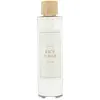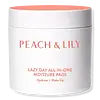What's inside
What's inside
 Key Ingredients
Key Ingredients

 Benefits
Benefits

 Ingredients Side-by-side
Ingredients Side-by-side

Water
Skin ConditioningMethylpropanediol
SolventTriethylhexanoin
MaskingHydrogenated Poly(C6-14 Olefin)
Emollient1,2-Hexanediol
Skin ConditioningNiacinamide
SmoothingPentylene Glycol
Skin ConditioningOryza Sativa Extract
AbsorbentPortulaca Oleracea Extract
Skin ConditioningUlmus Davidiana Root Extract
Skin ConditioningOryza Sativa Bran Extract
Skin ConditioningAmaranthus Caudatus Seed Extract
Skin ConditioningHydrogenated Lecithin
EmulsifyingGlycerin
HumectantPolyglyceryl-10 Myristate
Skin ConditioningButylene Glycol
HumectantEthylhexylglycerin
Skin ConditioningAdenosine
Skin ConditioningCellulose Gum
Emulsion StabilisingCaprylyl Glycol
EmollientTocopherol
AntioxidantWater, Methylpropanediol, Triethylhexanoin, Hydrogenated Poly(C6-14 Olefin), 1,2-Hexanediol, Niacinamide, Pentylene Glycol, Oryza Sativa Extract, Portulaca Oleracea Extract, Ulmus Davidiana Root Extract, Oryza Sativa Bran Extract, Amaranthus Caudatus Seed Extract, Hydrogenated Lecithin, Glycerin, Polyglyceryl-10 Myristate, Butylene Glycol, Ethylhexylglycerin, Adenosine, Cellulose Gum, Caprylyl Glycol, Tocopherol
Water
Skin ConditioningButylene Glycol
HumectantGlycerin
Humectant1,2-Hexanediol
Skin ConditioningBetaine
HumectantPanthenol
Skin ConditioningSodium Hyaluronate
HumectantSpinacia Oleracea Leaf Extract
Skin ConditioningDaucus Carota Sativa Root Extract
Skin ConditioningBrassica Oleracea Italica Extract
AstringentBrassica Oleracea Capitata Leaf Extract
Skin ConditioningBrassica Oleracea Acephala Leaf Extract
HumectantCeramide NP
Skin ConditioningHydroxyethyl Acrylate/Sodium Acryloyldimethyl Taurate Copolymer
Emulsion StabilisingCetearyl Olivate
Allantoin
Skin ConditioningPunica Granatum Fruit Extract
AntioxidantPrunus Persica Fruit Extract
AbrasiveLactobacillus/Soybean Ferment Extract
Skin ConditioningHydrogenated Lecithin
EmulsifyingSorbitan Olivate
EmulsifyingEthylhexylglycerin
Skin ConditioningXanthan Gum
EmulsifyingSodium Phytate
Sorbitan Isostearate
EmulsifyingSodium Citrate
BufferingCitric Acid
BufferingOpuntia Ficus-Indica Stem Extract
Skin ConditioningBambusa Vulgaris Water
Skin ConditioningCaprylic/Capric Triglyceride
MaskingPhytosteryl/Octyldodecyl Lauroyl Glutamate
Skin ConditioningPentylene Glycol
Skin ConditioningCaprylyl Glycol
EmollientCitrus Aurantium Bergamia Fruit Oil
MaskingWater, Butylene Glycol, Glycerin, 1,2-Hexanediol, Betaine, Panthenol, Sodium Hyaluronate, Spinacia Oleracea Leaf Extract, Daucus Carota Sativa Root Extract, Brassica Oleracea Italica Extract, Brassica Oleracea Capitata Leaf Extract, Brassica Oleracea Acephala Leaf Extract, Ceramide NP, Hydroxyethyl Acrylate/Sodium Acryloyldimethyl Taurate Copolymer, Cetearyl Olivate, Allantoin, Punica Granatum Fruit Extract, Prunus Persica Fruit Extract, Lactobacillus/Soybean Ferment Extract, Hydrogenated Lecithin, Sorbitan Olivate, Ethylhexylglycerin, Xanthan Gum, Sodium Phytate, Sorbitan Isostearate, Sodium Citrate, Citric Acid, Opuntia Ficus-Indica Stem Extract, Bambusa Vulgaris Water, Caprylic/Capric Triglyceride, Phytosteryl/Octyldodecyl Lauroyl Glutamate, Pentylene Glycol, Caprylyl Glycol, Citrus Aurantium Bergamia Fruit Oil
 Reviews
Reviews

Ingredients Explained
These ingredients are found in both products.
Ingredients higher up in an ingredient list are typically present in a larger amount.
1,2-Hexanediol is a synthetic liquid and another multi-functional powerhouse.
It is a:
- Humectant, drawing moisture into the skin
- Emollient, helping to soften skin
- Solvent, dispersing and stabilizing formulas
- Preservative booster, enhancing the antimicrobial activity of other preservatives
Butylene Glycol (or BG) is used within cosmetic products for a few different reasons:
Overall, Butylene Glycol is a safe and well-rounded ingredient that works well with other ingredients.
Though this ingredient works well with most skin types, some people with sensitive skin may experience a reaction such as allergic rashes, closed comedones, or itchiness.
Learn more about Butylene GlycolCaprylyl Glycol is a humectant and emollient, meaning it attracts and preserves moisture.
It is a common ingredient in many products, especially those designed to hydrate skin. The primary benefits are retaining moisture, skin softening, and promoting a healthy skin barrier.
Though Caprylyl Glycol is an alcohol derived from fatty acids, it is not the kind that can dry out skin.
This ingredient is also used as a preservative to extend the life of products. It has slight antimicrobial properties.
Learn more about Caprylyl GlycolEthylhexylglycerin (we can't pronounce this either) is commonly used as a preservative and skin softener. It is derived from glyceryl.
You might see Ethylhexylglycerin often paired with other preservatives such as phenoxyethanol. Ethylhexylglycerin has been found to increase the effectiveness of these other preservatives.
Glycerin is already naturally found in your skin. It helps moisturize and protect your skin.
A study from 2016 found glycerin to be more effective as a humectant than AHAs and hyaluronic acid.
As a humectant, it helps the skin stay hydrated by pulling moisture to your skin. The low molecular weight of glycerin allows it to pull moisture into the deeper layers of your skin.
Hydrated skin improves your skin barrier; Your skin barrier helps protect against irritants and bacteria.
Glycerin has also been found to have antimicrobial and antiviral properties. Due to these properties, glycerin is often used in wound and burn treatments.
In cosmetics, glycerin is usually derived from plants such as soybean or palm. However, it can also be sourced from animals, such as tallow or animal fat.
This ingredient is organic, colorless, odorless, and non-toxic.
Glycerin is the name for this ingredient in American English. British English uses Glycerol/Glycerine.
Learn more about GlycerinHydrogenated Lecithin is created from the hydrogenation of lecithin (a group of phospholipids). Hydrogenation is a chemical reaction between hydrogen and another element.
This ingredient is an emollient and emulsifier. As an emollient, it helps soften skin by trapping moisture within. As an emulsifier, it prevents oil and water ingredients from separating.
Pentylene glycol is typically used within a product to thicken it. It also adds a smooth, soft, and moisturizing feel to the product. It is naturally found in plants such as sugar beets.
The hydrophilic trait of Pentylene Glycol makes it a humectant. As a humectant, Pentylene Glycol helps draw moisture from the air to your skin. This can help keep your skin hydrated.
This property also makes Pentylene Glycol a great texture enhancer. It can also help thicken or stabilize a product.
Pentylene Glycol also acts as a mild preservative and helps to keep a product microbe-free.
Some people may experience mild eye and skin irritation from Pentylene Glycol. We always recommend speaking with a professional about using this ingredient in your routine.
Pentylene Glycol has a low molecular weight and is part of the 1,2-glycol family.
Learn more about Pentylene GlycolWater. It's the most common cosmetic ingredient of all. You'll usually see it at the top of ingredient lists, meaning that it makes up the largest part of the product.
So why is it so popular? Water most often acts as a solvent - this means that it helps dissolve other ingredients into the formulation.
You'll also recognize water as that liquid we all need to stay alive. If you see this, drink a glass of water. Stay hydrated!
Learn more about Water